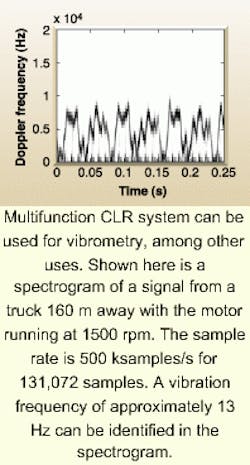Single CLR system serves many functions

Most coherent-laser-radar (CLR) systems are specific to a single application because it is difficult to optimize the performance of a system for more than one function. For decades, CLR systems have been used for remote sensing. Carbon dioxide-laser-based CLR systems have been developed for wind measurements as well as for hard target measurements such as ranging. More recently, pulsed 2-µm systems have been designed for specific wind measurement applications. Both short-range and long-range vibrometry systems have also become commercially available. Now, researchers with the Defence Research Establishment at the Department of Laser Systems (Linköping, Sweden) have presented results on the design and performance of a multifunction continuous-wave (CW) CLR system at 1.55 µm. The system is designed for use in multiple applications while minimizing cost and size that have previously limited multifunction systems.1
The researchers report that the multifunction system has demonstrated its performance in many applications, including wind speed measurements in clear atmospheric conditions, vibrometry, and Doppler shift ranging. Wind speed measurements can be performed in backscatter radiation mode using large volumes of particles or in aerosol measurements, indicating a potential for distant single-particle detection at a laser output of 5 mW. The lowest aerosol spectrum detected in the trials corresponded to a visibility exceeding 40 km. The researchers report that this CLR system is, to their knowledge, the first 1.55-µm system capable of wind measurements in seemingly all conditions encountered near the ground. The system performs range and line-of-sight velocity measurements of hard targets at ranges on the order of several kilometers with a range and speed accuracy of a few meters and approximately 0.1 m/s, respectively.
Because the source emits at a wavelength of 1.55 µm, the CLR system uses technology and components already proven in the telecommunications industry, which conserves cost. A smaller and more robust system results from the use of semiconductor lasers and erbium-doped fiber amplifiers.
The CLR system gives an output power of 1 W, using a distributed-feedback (DFB) semiconductor laser source plus a polarization-independent fiberoptic circulator for the transmit-receive switch, and digital signal processing. The instrument is designed to be insensitive to the polarization state within the fiber and of the laser source. The distributed-feedback (DFB) diode can be used in stable, CW mode as well as frequency-modulated (FM) CW mode. A master-oscillator power-amplifier (MOPA) configuration uses the FM properties of the DFB diode combined with the high power levels available through the use of fiber amplifier technology. The MOPA configuration thus allows for a multifunction system with a single laser source. For further details, contact [email protected].
REFERENCE
- C. J. Karlsson, F. Å. A. Olsson, D. Letalick, and M. Harris, Appl. Opt. 39, 3716 (July 20, 2000).
About the Author
Valerie Coffey-Rosich
Contributing Editor
Valerie Coffey-Rosich is a freelance science and technology writer and editor and a contributing editor for Laser Focus World; she previously served as an Associate Technical Editor (2000-2003) and a Senior Technical Editor (2007-2008) for Laser Focus World.
Valerie holds a BS in physics from the University of Nevada, Reno, and an MA in astronomy from Boston University. She specializes in editing and writing about optics, photonics, astronomy, and physics in academic, reference, and business-to-business publications. In addition to Laser Focus World, her work has appeared online and in print for clients such as the American Institute of Physics, American Heritage Dictionary, BioPhotonics, Encyclopedia Britannica, EuroPhotonics, the Optical Society of America, Photonics Focus, Photonics Spectra, Sky & Telescope, and many others. She is based in Palm Springs, California.
